The Convict Valley: the bloody struggle on Australia's early frontier
Clashing cultures, clashing classes, rampant land grabs and dispossession of the original inhabitants are the central themes in this history of the Hunter Valley.
READ REVIEW
↓
The Convict Valley: The bloody struggle on Australia’s early frontier
Mark Dunn | June 2020
The Convict Valley is a beautifully narrated history that uncovers many long-forgotten or seldom-acknowledged histories about the establishment of early colonial Newcastle and the Hunter Valley. Concentrating on the early years of European intrusion into this region, Dunn traces the complex relationships forged between the original Aboriginal inhabitants, convicts and free settlers from 1790 to 1850. Accessing an extensive array of archival records, including government papers, settler letters and diaries, newspaper articles, artworks and archaeological reports, Dunn has added a new dimension to the history of Newcastle and the Hunter Valley.
Acknowledging the deep time history of this ancient landscape, shaped by ancient forces and skilfully managed by the ancestors of the present custodians, the Worimi, the Awbakal, the Wonnarua, the Kamilaroi and the Birpai peoples, Dunn takes the reader on a journey. Setting out with early European explorers from Windsor and the Hawkesbury River districts, he traces the often perilous excursions undertaken by explorers including Howe, Singleton and Blaxland. Highlighting the important role of Aboriginal guides, he brings to the fore the somewhat complex and intriguing relationships they formed with a number of colonisers.
Dunn also exposes the many serendipitous contacts between convicts and Aboriginal peoples. He adds narrative texture and substance to the stories of escaped convicts, including John Tarwood, Joseph Sutton, George Lee, George Conoway and John Watson, who found a place of temporary or permanent belonging with Aboriginal family groups, some producing offspring. Conversely, some Aboriginal people or groups aligned themselves with government establishments and landholders who aided the authorities in tracking and returning escaped convicts. Layered against these relationships, the narrative uncovers the recurring violence between convicts, landholders and Aboriginal peoples. Retaliation by overseers and gentleman farmers regularly prompted a cycle of violence for stock losses that lasted for months or years and built prejudice and mistrust.
Established as a penal station for reoffenders, Newcastle’s initial isolation from Sydney and its convict workforce meant it soon gained a reputation for brutality. Dunn introduces the humble beginnings of the town as a site for the coal mining industry – the main reason for the location of the penal settlement – timber cutting and lime burning; materials used to fuel the rapidly developing Sydney. Identifying the location of some colonial industries helps the reader to reflect on their present-day usage. Aboriginal place names were over-written as colonial encroachment increased, substituted with names more in keeping with colonial aspirations and obliterating thousands of years of Aboriginal occupation. Dunn reminds us that this is all Aboriginal land.
Key to the history of Newcastle and the Hunter Valley are the effects of expansionist land policies. Following the early explorers who opened up tracks from Windsor north into the Hunter Valley, Dunn uncovers the layers of histories of land acquisition and those who acquired it. The land allotted to emancipated convicts was in closed proximity to free settlers and retired military officers. This exacerbated the hierarchical factions structured by an imported class system. Dunn’s meticulous research uncovers the complexity of these relationships and the consequences for many Aboriginal peoples, increasingly marginalised from their land and traditional food sources. Each retelling provides a fascinating series of vignettes of the diverse interpersonal dynamics at play. Positive, negative and symbiotic relations existing between colonisers and Aboriginal peoples, however, were overshadowed by the settlers’ sense of entitlement and the mounted police’s use of force to subdue Aboriginal ‘outrages’ ensured overt violence on this frontier continued until Aboriginal people were permanently subdued.
The incorporation of a selection of artworks as evidence draws attention to salient points in the narrative. These beautifully reproduced images, many from the State Library of New South Wales and the National Library of Australia, range from portraits of key protagonists to scenes of campsites, Aboriginal hunting practices and their technologies. They include works by the convict artist Joseph Lycett and Captain James Wallis. This introduces the reader to colonial aesthetics and how these artists interpreted their surroundings and the people who populated the valley.
Mark Dunn, the immediate past president of PHA (NSW & ACT), is a leading historian and heritage consultant, who has spent many years researching the colonial past of Sydney and the Newcastle region. His expertise shines in this fascinating study of the Hunter Valley.
Reviewer: Dr Jennifer Debenham, PHA (NSW & ACT)
The Convict Valley is published by Allen & Unwin.

